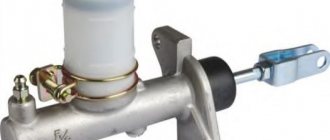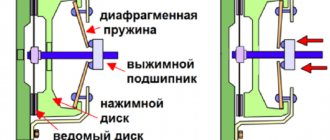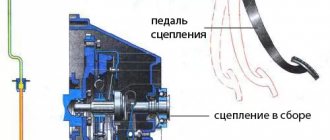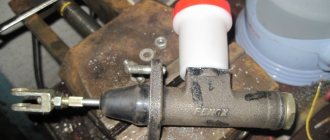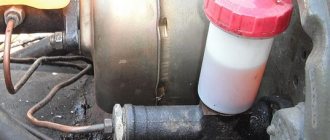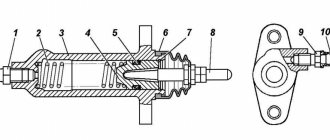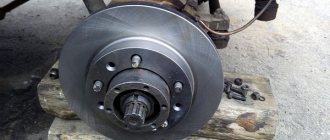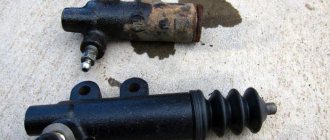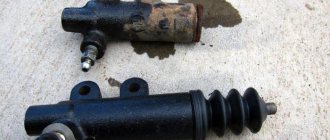If we simplify the formulation of the actions performed by the clutch drive, it will sound like this - the transmission of torque from the motor to the corresponding gearbox shaft with the ability to disable and then softly engage after switching to the desired gear. Nowadays, designers have not yet come up with anything more effective for achieving this goal than a hydraulic clutch drive. The diagram and principle of operation of the described device is simple: a depressed pedal acts on the clutch cylinder rod, which, accordingly, using hydraulic fluid located in the tank through tubes, activates, through the working cylinder, the fork and the release bearing.
Failure of the clutch drive occurs for several reasons, one of which may be a faulty clutch master cylinder; in order to repair it, it is advisable to understand its structure, signs indicating the inoperability of the mechanism, methods of repair, and if repair is not possible, then how to make it replacement.
How is the clutch master cylinder constructed?
The clutch system performs the function of briefly disconnecting the internal combustion engine from the gearbox. As a result, the transmission of torque from the power unit to the drive shaft of the transmission stops. This system includes many components. One of them is the clutch master cylinder, which we will talk about today.
What is he?
This mechanism is a small casting made of cast iron steel with a flange for attachment to the body. On its top there is a plastic tank with a lid. It is attached to the body using a threaded fitting. Thanks to this mechanism, a special fluid enters the clutch master cylinder. Inside the cast iron part there is a piston with a cuff and an o-ring. There is also a spring resting on the check valve. It compresses the piston to the extreme right. When these parts are heated, expansion occurs, and accordingly, the liquid in the system must go somewhere. For these cases, there is a special compensation hole through which it enters the tank from the cylinder cavity.
How does the VAZ 2107 clutch master cylinder work?
This mechanism is designed in such a way that each time you press the clutch pedal, it moves forward using a pusher. And when the piston closes the hole, the pressure in the cylinder increases. Thus, the fluid flows to the working cylinder and disengages the clutch. When the pedal is released, a similar action occurs, only in reverse order. The liquid flows back - the valves open, the spring compresses and it moves from the working cylinder to the main one. If the pressure level drops to a point below the spring compression force, the first part closes and more pressure is generated in the system. This is necessary to sample the gaps of the mechanical part of the drive.
If the pedal is released abruptly, then the liquid will not completely fill the space behind the piston. Then a vacuum occurs in the clutch master cylinder. Because of this, the liquid will flow from the plastic tank through the bypass hole directly into the piston. Then it passes through the piston head and fills all the space that appeared in the part after the vacuum. At the same time, the liquid removes the edges of the cuff and pushes the spring plastic aside. And again, if it becomes more than normal, all of its excess passes through a special compensation hole back into the tank.
This is exactly how the VAZ clutch master cylinder is designed. In conclusion, I would like to note several ways by which you can independently identify the breakdown of this mechanism:
- First, you should check the level of working fluid in the tank. If this indicator drops rapidly, this indicates a malfunction of the piston or cuff.
- Secondly, this part is replaced if you feel the characteristic sound of gears when changing gears.
- Thirdly, the clutch cylinder is replaced when the gearshift knob vibrates.
Tips and tricks
When purchasing a new part, owners should remember the quality of the unit, since there are often cases when a cheap product suffers from a short service life. There are many fakes of the VAZ 2104 clutch master cylinder on the market, which are characterized by low quality workmanship and a short service life. The optimal solution is to purchase parts from the manufacturer, which in its production complies with strict standards and GOST norms. At the same time, using the identification number, it is always possible to determine the batch number in the event of a manufacturing defect.
Also, when choosing a new part, owners need to pay special attention to the quality of workmanship. There should be no backlash in some of the moving parts; the parts should maintain optimal mobility. The presence of cracks, stains of unspecified liquid, and burrs on the body is unacceptable. Also, the body, like the rest of the parts, must be numbered with the standard stamp of the manufacturer.
During the repair process, you must always keep a drain container for used brake fluid on hand. Also, before repairs, it is necessary to purchase about a liter of such a substance to make up for losses from opening the system. It is also necessary to remember that reassembling the system after repair must be done in exactly the reverse order. Otherwise, new faults may appear. Moreover, during the assembly process, all parts must also fit tightly to each other, in order to avoid breakdowns in the future.
Clutch slave cylinder - operating principle. Repair and replacement.
As you know, on rear-wheel drive cars of domestic production, the clutch is released not by a cable as on front-wheel drive counterparts, but with the help of hydraulics, I will now tell you in a little more detail about how this happens.
How it works.
When you press the clutch pedal with your foot, the metal rod presses on the piston, which in turn creates pressure. Under this pressure, the liquid through a system of tubes reaches the working cylinder, to which a rod with a fork is attached, and under the influence of hydraulic pressure, the rod presses the release bearing and disconnects the engine from the transmission. After releasing the clutch pedal, the spring returns the engagement of the engine and gearbox. A very sophisticated way to release the clutch. Moreover, squeezing a hydraulic clutch is somewhat more pleasant than squeezing a cable clutch. If you compare them, the hydraulics work much softer and smoother.
Due to the appearance of an “extra” structure in the form of a pair of cylinders and aluminum tubes, which tend to constantly leak, we are gradually moving on to repairing and replacing the cylinders.
Repair and replacement of the clutch slave cylinder.
1. First of all, you need to pump out the hydraulic fluid using a syringe.
2. For ease of dismantling, remove and put aside the expansion tank.
3. Using a 10″ socket, unscrew the nuts securing the clutch barrel from which we pumped out the fluid and remove the hose.
4. Unscrew the aluminum tube coming from the clutch master cylinder.
5. Using a 13″ socket, unscrew the two nuts securing the clutch master cylinder and pull it towards you.
6. Using a 17″ wrench, unscrew the hose from the working cylinder.
7. Using a 13″ socket, unscrew the two nuts securing the clutch slave cylinder and remove it. After the working cylinder is dismantled, it needs to be inspected for damage to the cylinder and piston, but if everything is in order with them, you can try to repair it. To do this, you will need a repair kit, which contains three different cuffs and a boot. The working cylinder is disassembled and the old cuffs are replaced with new ones. Finally, install a new boot.
If the working cylinder cannot be repaired, then we buy a new one and screw the nut onto it at the same distance as on the old cylinder.
The price for a new clutch slave cylinder ranges from 270 to 450 rubles, and a new master cylinder will cost 300-500 rubles, depending on the region.
Popular models and manufacturers
When choosing a non-original clutch slave cylinder, products from the following manufacturers are most often used:
- Sachs. The German company is a leading manufacturer of clutch cylinders for most automobile brands of foreign and domestic manufacturers. The popularity is due to the high quality of products and the use of innovative developments.
- Lukas. The largest manufacturer of auto parts, whose products meet all international quality standards. It produces brake cylinders for most automobile brands and repair kits for them.
- Fenox. Specializing in the production of clutch and brake cylinders for more than 25 years. Supplies products to most automakers.
- TRW. The company owns the Lukas brand and supplies brake system components, in particular brake cylinders, for all the world's largest automakers. The products are distinguished by their quality and extreme reliability.
- LUK. Official partner of major automakers in terms of designing new developments and systems. Supplies clutch cylinders to assembly lines of most of the world's major automakers.
Source
Description and testing of the clutch
Description and testing of the clutch
Models with RT are equipped with a dry-type single-plate clutch with a diaphragm spring.
Components of a Typical Clutch Assembly
| 1 - Pressure plate 2 - Clutch plate 3 - Shift lever 4 - Release bearing 5 - Ball pin 6 - Lever mounting spring |
The clutch is operated by a hydraulic system.
When the clutch pedal is depressed, hydraulic fluid (pressured by the clutch master cylinder) transfers power to the slave cylinder. Since the slave cylinder is connected to the clutch release fork, the release fork brings the release bearing into contact with the pressure plate petals, disengaging the clutch disc.
The hydraulic system adjusts the clutch automatically, so no additional actuator or pedal adjustment is required unless you have replaced the clutch master cylinder and/or pushrod.
When working with the instructions, problems may sometimes arise with terminology related to clutch components, because... Different manufacturers, auto parts store salespeople, and car dealers call the same parts differently. For example, the driven disc is also called the clutch disc and the friction disc; the slave cylinder is sometimes called the working cylinder, etc.
Components with obvious damage should be replaced, but for cases where the cause of system failure is not so obvious, here are a few preliminary diagnostic checks.
|
Symptoms of problems
The general technical condition of the car (including the brake system) can be checked using a personal diagnostic adapter - a car scanner. These types of devices are widespread and have a wide price range.
We would like to draw your attention to the budget model of Korean production Scan Tool Pro Black Edition
At a cost of about 2 thousand rubles. This scanner is capable of fully diagnosing your car (engine, gearbox, transmission, abs, srs and much more), which will pay for itself in 1-2 trips to the service station. The adapter is quite easy to use, has Russian-language software and is compatible with most cars produced in 1993. The device will also be useful when buying a used car, as it can show its real mileage and VIN.
The fluid brake system consists of many parts that can become unusable: pipes, wheel cylinders, calipers, drums and pads. Typical signs of a faulty master cylinder:
- After pressing the pedal, the car stops slowly. The reason is that the cuffs of one or two pistons have lost their tightness - they have cracked or “floated”.
- To slow down, you need to press the brake pedal hard. The phenomenon occurs due to swelling of the rubber of the piston seals.
- The brake pedal travel is too short. The fluid inside the cylinder has nowhere to go because the compensation hole is clogged. Another option is that the passage is blocked by a swollen rubber seal.
- A common symptom is pedal failure, the brakes coming on at the end of the stroke. This indicates complete wear of the cuffs; as a result, liquid penetrates behind the piston and rushes into the expansion tank - the cylinder “bypasses.”
- The pads do not release the brake discs and drums and get very hot when driving. Options: one of the pistons is jammed or the bypass hole is clogged.
The listed symptoms of a GTZ malfunction are similar to malfunctions of other elements. Pedal failure also occurs when a large amount of air enters the tubes or loss of fluid in one of the working cylinders. Sluggish deceleration and increased force on the pedal are often caused by a breakdown of the vacuum booster - a cracked membrane or a lack of tightness at the joints of the hose that takes off engine vacuum.
There are signs that clearly indicate the performance of the main hydraulic cylinder and the malfunction of other elements:
- during braking, the car pulls to the side - the problem lies in a certain circuit or wheel;
- jamming of the brake mechanisms of one wheel;
- creaking and squeaking when braking;
- heating the discs and pads on one wheel.
If you eliminate these symptoms, it will become easier to check the brake master cylinder in a garage. This also includes obvious brake fluid leaks and the knocking sound of worn calipers.
Clutch master cylinder - design, repair and replacement
If we simplify the formulation of the actions performed by the clutch drive, it will sound like this - the transmission of torque from the motor to the corresponding gearbox shaft with the ability to disable and then softly engage after switching to the desired gear. Nowadays, designers have not yet come up with anything more effective for achieving this goal than a hydraulic clutch drive. The diagram and principle of operation of the described device is simple: a depressed pedal acts on the clutch cylinder rod, which, accordingly, using hydraulic fluid located in the tank through tubes, activates, through the working cylinder, the fork and the release bearing.
Failure of the clutch drive occurs for several reasons, one of which may be a faulty clutch master cylinder; in order to repair it, it is advisable to understand its structure, signs indicating the inoperability of the mechanism, methods of repair, and if repair is not possible, then how to make it replacement.
Device
Possible malfunctions and their diagnosis
Repair work
If the pedal fails, in order to avoid unreasonable disassembly of the cylinder, it is worth initially pumping the system and expelling air from there that could get in when the liquid in the tank drops below the minimum permissible level. If this does not help in principle, it is worth starting repairs. For this case, there is a repair kit for the clutch master cylinder on sale, which, depending on the make of the car, contains the main wearing parts: cuffs, return spring, rod, retaining ring, etc.
The master cylinder is located under the clutch pedal. Depending on the car model, dismantling will have to be done either from the engine compartment or from the car interior, having previously dismantled the floor covering in the driver’s area. Having removed the clutch master cylinder, we begin disassembling it, after which we need to wash all the parts. During the subsequent inspection, after disassembly, it is worth paying special attention to the body and the condition of the rod and mirror; if there are visible scuffs, this may indicate the appearance of wear in the cylinder or wear of the rod.
In general, experienced craftsmen recommend changing all the parts in the repair kit, especially the cuffs.
Hydraulic drive device
The hydraulic drive system has the same design for all types of cars, and includes well-known elements:
- directly the clutch pedal;
- clutch master cylinder located immediately behind the pedal;
- Next comes the working cylinder;
- clutch fork;
- bearing;
- pipelines.
The master cylinder itself cannot boast of complexity - the steel case contains a piston with a pusher and cuffs that serve to ensure the tightness of the entire system within which the working fluid circulates. It takes the load from the pedal, increases it and transmits it further, providing a quick interruption in the transmission of torque from the engine when a person needs it.
Other signs of clutch failure
When the friction linings wear critically, the behavior of the car changes significantly. The following are signs of a burnt coupling:
- It is difficult to start moving. The car can remain stationary even when the clutch pedal is fully released. This means that the disc is not pressed enough to transmit torque to the transmission. Here you can judge the critical wear of the driven disk.
- Car jerking while driving. In this case, you can still start moving, but the start will create discomfort - the car jerks strongly. When the speed increases, the jerking disappears. However, the next time you try to drive from first gear, the jerking and vibration will appear again. In addition, the car may accelerate atypically when switching to higher speeds. Since the disk is not pressed tightly enough to the flywheel, the torque is transmitted intermittently. The car loses acceleration dynamics. If you disassemble the coupling, you can see the play of the diaphragm springs. They are responsible for compensating and smoothing the loads coming from the flywheel to the transmission. If such play is detected, the mechanism must be replaced.
- Free play of the clutch pedal.
Based on these signs, you can judge whether the clutch is faulty without additional diagnostics. However, to get the full picture, it is better to contact specialists.
After we have decided on troubleshooting, it’s time to choose the best clutch kit for your car, our rating.
DIY repair
Since the main cylinder, despite its importance, is designed quite simply, it is quite possible to repair it yourself without contacting specialized service centers. Of course, this will require spending some time and money, but it is much more important to have a fully functional clutch system, the sudden failure of which can end quite sadly. In order to always be able to count on your car, you should periodically diagnose its main components and systems.
Despite its importance, checking the master cylinder is a simple procedure - periodic visual inspections and checking the brake fluid level are sufficient. These actions are carried out literally in a few minutes, because if the clutch master cylinder leaks, the symptoms of this problem will be obvious - the surface of the cylinder will be stained, the level of brake fluid in the reservoir is below the established norm. At the same time, its complete replacement is not always necessary, because almost every car owner can sort out the old cylinder.
Tools, accessories, consumables
When repairing or replacing the clutch master cylinder, you need basic knowledge of its structure, as well as its location. During the work itself, you should have a small set of tools at your disposal, and often a Phillips screwdriver and a wrench may be enough. This will be enough to independently dismantle the cylinder, eliminate possible malfunctions or completely replace it, as well as install it in place.
Additional tools that will be needed for repair work can be a dry and clean rag, a syringe, a container for drained brake fluid, as well as a long hose, the diameter of which will allow it to fit tightly onto the air valve.
As for consumables, you should immediately take care of purchasing brake fluid of the same brand that was filled before. If there is no information about the old fluid, it is necessary to purchase an additional special flush, which will avoid possible troubles due to their incompatibility.
Possible malfunctions and their causes
As such, there are no faults classified as serious and difficult to fix in the clutch master cylinder. Among the most common are the following:
- airiness of the system;
- leakage of working fluid;
- mechanical wear of cylinder elements.
Air ingress can become a serious problem, making normal operation of the hydraulic drive impossible. The reason for air getting inside the system is often microcracks in the connecting hoses or sealing cuffs itself. In order to eliminate the possibility of failure, the system requires bleeding. It can be performed independently, since no special skills or special tools are required. The procedure is quite standard, and most car owners are familiar with it firsthand.
If, when checking the system, you constantly need to add brake fluid to the reservoir, you should carefully look for the place of its leak - it may not only be the clutch master cylinder. A fluid leak is dangerous primarily because the cylinder will not be able to generate sufficient force to move the clutch fork, and the driver will not be able to break the connection between the engine and the wheels by pressing the pedal. If the leak is caused by problems with the connecting pipes, replacing them is easy; if the problem is in the cylinder itself, to repair it yourself you will have to dismantle it, disassemble it and find out the cause experimentally. Faults in the clutch master cylinder cannot be detected by eye.
Installation or replacement
Removing or replacing the clutch slave cylinder is carried out in the following order:
- Unscrewing the pair of bolts securing the cylinder body to the clutch housing.
- Disconnecting the pusher from the clutch fork.
- Disconnecting the hose connecting the clutch slave and master cylinders.
- Plug the hose with a suitable size plug to prevent liquid leakage.
Installing a new or repaired wheel cylinder is carried out in the reverse order, after which the system is pumped to fill it with brake fluid and remove air. During assembly, a special lubricant is applied to the pusher axis, usually CASMOLY L9508.
DIY master cylinder repair
To carry out the work, the entire assembly will have to be completely dismantled, having first disconnected all the pipes and drained the liquid from the system. You should also prepare in advance a repair kit for the clutch master cylinder, which includes all parts subject to wear. Despite the fact that the “composition” of the clutch master cylinder is not complicated, it is advisable to carry out the work by persons who have at least minimal experience in plumbing work. If the question of how to remove the clutch master cylinder is completely unclear, it is better to abandon repairs yourself and simply replace the cylinder with a new one.
After dismantling, you can begin disassembly, which should be done in a clean and well-lit place. Having disassembled the cylinder, all its parts are thoroughly washed with brake fluid - it is unacceptable to use solvents or gasoline for this purpose. It is also advisable to wash all parts from the repair kit that are planned to be used before installation. It is advisable to start removing the clutch master cylinder in the morning, especially if serious problems with the hydraulic drive were noted during the operation of the car - it may well turn out that the cylinder will not be suitable for repair, and you will urgently have to purchase and install a new one. You can watch the video to see how to replace the cylinder with your own hands:
Visual inspection of parts - what to look for
After dismantling and completely disassembling the master cylinder into its component elements, you can begin to assess the technical condition of all parts, which by that time have been washed and dried. First of all, carefully inspect the piston, mirrors and sealing elements. Quite often, pockets of corrosion can be found on internal surfaces; they can be eliminated by careful treatment with fine-grained sandpaper. Although, if the corrosion areas are multiple, extensive, and accompanied by the presence of scuffing, you should think twice about it, since this indicates a violation of the gap between the piston and the cylinder walls.
All sealing elements are inspected either very carefully, or new ones are immediately prepared, which in any case is more advisable. There may not be obvious signs of integrity damage on them, but when working under pressure, the slightest defects will inevitably lead to fluid leaks from the cylinder. After all faults have been eliminated, the device can be assembled, strictly following the sequence of manipulations.
The cylinder repair is complete, what next?
After replacing the clutch master cylinder or repairing and reinstalling the old one, it is almost always necessary to bleed the clutch system. This is a necessary measure to eliminate accumulated air bubbles, the presence of which is not allowed in the hydraulic drive system. During repairs, air inevitably enters the system, and if it is not removed, clutch problems will soon arise. The whole pumping procedure is not so complicated and does not require much time. If the replacement was carried out at a service center, its mechanics use heavy vacuum pumps to remove air from the cylinder, and bleeding of the system is not required.
For bleeding, it is necessary to provide free access to the master cylinder, and for this it will be more convenient to drive some vehicle models into a pit or lift them on a hydraulic lift. New brake fluid is poured into the reservoir, a transparent tube is put on the fitting, the end of which is lowered into a container with the same working fluid. By rhythmically operating the clutch pedal, the hydraulic drive is pumped until the release of air through the fitting stops completely. After this, the fitting is tightened and the car is ready for use.
Despite the apparent “insignificance” of this procedure, the operating principle of the clutch master cylinder does not allow the hydraulic drive to function normally in the presence of air. If bleeding is not performed, even after replacing the unit with a new one, all the characteristic signs of a malfunction of the clutch master cylinder will very quickly begin to appear, negating all previously applied efforts.
Hydraulic clutch bleeding procedure
After replacing or repairing both the main and slave cylinders, the driver will have to bleed the clutch hydraulic drive, since air gets into the machine’s hydraulics. There is no way to avoid this. Therefore, you will have to call your partner for help and start pumping.
Sequence of work
To bleed, you will need the following things: an old plastic bottle, a piece of hose about 40 cm long, a 12 mm spanner.
- The car is installed on the pit and securely fixed.
The clutch slave cylinder fitting is clearly visible from the inspection hole. A piece of rubber hose is placed on this fitting so that the fitting nut remains outside. The other end of the hose is placed in a plastic bottle. The second end of the hose is placed in a plastic bottle - Now the union nut is loosened a couple of turns. After this, the partner sitting in the cockpit squeezes the clutch five times. After pressing for the fifth time, he continues to hold the pedal down.
- At this time, brake fluid with an abundance of bubbles will flow from the hose into the bottle. As soon as it stops flowing, you should ask your partner to squeeze the pedal five more times and then hold it again. This must be done until the liquid coming from the hose stops bubbling. If this has been achieved, pumping is considered complete.
- Now the hose is removed from the fitting, the fitting itself is tightened, and a new portion of brake fluid is added to the reservoir.
So, the master cylinder is the most important element in the VAZ 2106 clutch system. But replacing it does not require special knowledge and skills, so even a novice driver can cope with this task. To successfully replace the cylinder, you just need to be a little patient and strictly follow the above recommendations.
